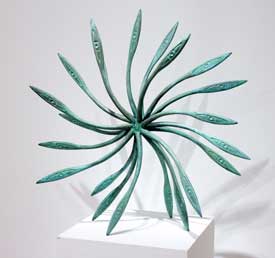James Surls: Recent Sculpture
By D. Eric Bookhardt, Gambit Weekly
Rugged, blue jean clad and with a speaking style somewhere between Joseph Campbell and Johnny Cash, James Surls may be the

Walking Eye Flower, Bronze with patina, 32 x 32 x 18 inches, 2008, by James Surls
most famous Texas artist. A native of the prairie bayou country extending from Houston to Lafayette, he’s known for sculpture that looks as if it grew out of that very soil, and while fellow Texans Robert Rauschenberg and Julian Schnabel are better known, they both became New Yorkers somewhere along the way. When Surls moved north to Colorado a decade ago, it caused no change in his vision, a heady mix of the earthly and the cosmic. Those traits characterize his abstract graphite line drawings, which in turn explicate his iconic sculptures, hybrid wood and metal concoctions with an ethereal monumentality that causes them to linger in the imagination.
Standing Knife, Pinon, and Morning Glory is a 10-foot-tall bronze, mahogany and stainless steel piece that suggests a skeletal flower atop a huge wooden blade. Here Surls alludes to the symbolism of male and female, but its inner meaning suggests a kind of prairie alchemy involving his notion of “conjuring — from the land, the wind and the bayous.” The sheer heft of his materials can make some of these works seem earthbound even as similar concepts make his drawings sparkle with magical intent. But Head and Hoof — a long pine tree root topped with flower-petal or propeller-like forms — eludes gravity’s pull, partly because it hangs suspended, and partly because its radial forms atop the spindly armature of the root evoke an eerie energy not unlike magnetic levitation. Walking Eye Flower (pictured), a bronze pedestal sculpture, melds the ethereal abstraction of the drawings with a hint of the heft of the others in a snaky pinwheel with many eyes, a tumbleweed prairie demon dancing like Shiva in the convection currents. Here Surls mines the earthy expanses for their hidden meanings, which he distills into poetic wood and metal manifestos that speak the language of the land.
